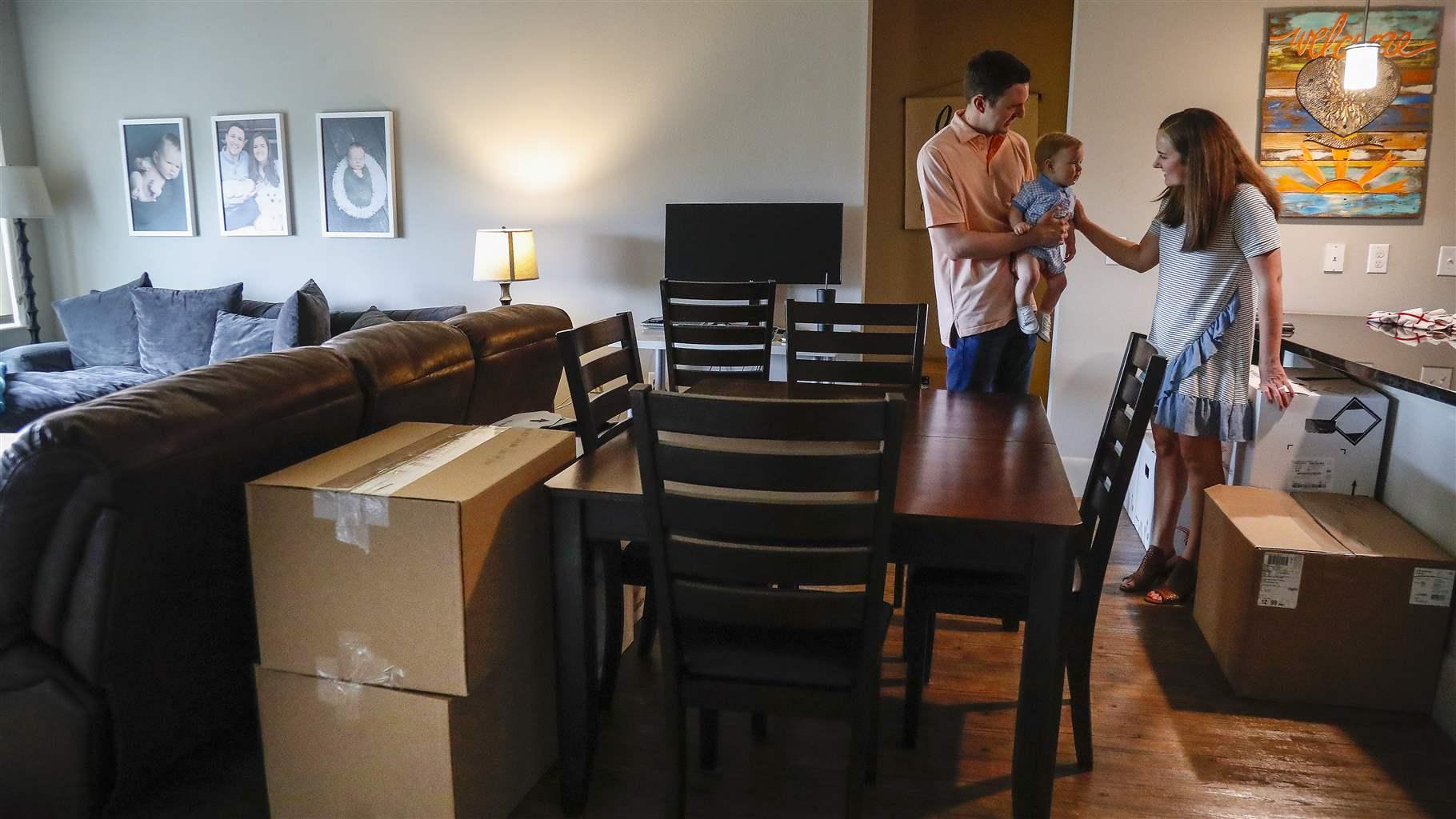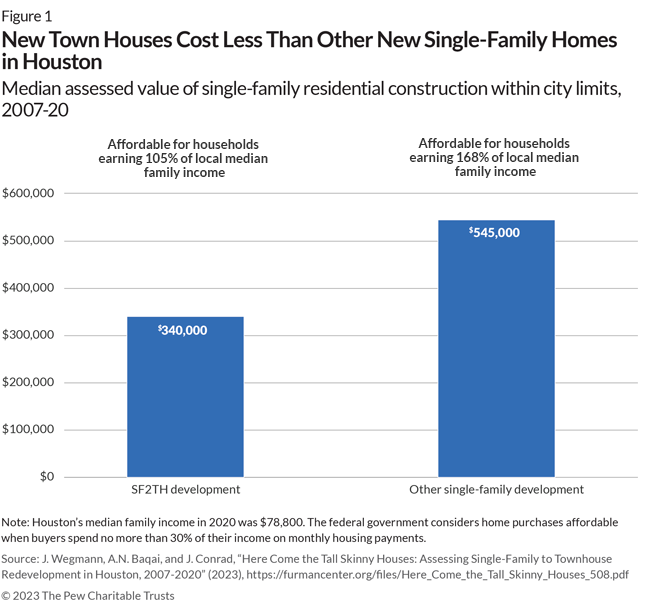Lot-Size Reform Unlocks Affordable Homeownership in Houston
By reducing the minimum parcel sizes, city made family-sized town houses viable

Overview
Spurred by high and rising housing costs, policymakers across the country are seeking ways to make homes more affordable for Americans at all income levels. And increasingly, state and local leaders are considering land-use and zoning reforms—especially those that can enable a greater range of housing types in neighborhoods previously limited to single-family homes on large lots—as part of the solution.
Despite an extensive body of research showing that restrictive zoning has hurt affordability, reforms often face opposition from critics who say that new development will harm the character of residential areas, create only expensive units, and lead to gentrification of neighborhoods occupied by people of color. But a new study from researchers at the University of Texas at Austin (UT Austin), published by New York University’s Furman Center and sponsored by The Pew Charitable Trusts, shows that zoning reform can increase the availability and affordability of housing without these adverse effects.1
The UT Austin team analyzed a policy change in Houston that relaxed the city’s minimum-lot-size requirement and enabled development of over 34,000 town houses from 2007 to 2020. More than 80% of the houses were constructed on parcels formerly occupied by commercial, industrial, or multifamily properties, but the study focused on 1,392 lots where town houses replaced single-family homes during the study period. Rules that allow only detached houses on large lots are often at the center of debates about zoning, and this study helps to shed light on how land-use reform affects urban residential neighborhoods.
The research found that single-family-to-town house (“SF2TH”) conversions did not result in sweeping changes to neighborhood character and that redevelopment was unlikely on any given residential lot in Houston. Just 0.5% of all single-family parcels underwent SF2TH conversion, with the typical case involving replacement of an old, small single-family home on a large lot with four larger town houses that were affordable to families with moderate incomes. Further, neighborhoods where SF2TH redevelopments occurred had above-average home values in 2000 while the percentages of Black residents were below average. Together, these findings suggest that SF2TH conversions helped to increase the number of available homes—and therefore households—in high-demand areas without driving out existing residents, belying a claim commonly made by opponents of land-use reform that new development in dense urban communities would lead to gentrification.
Houston’s lot-size reform offers lessons for policymakers across the country, demonstrating how relatively small land-use policy changes can enable development of low-cost family-sized housing and encourage diversity without harming the character of residential neighborhoods.
Houston enabled development by reducing minimum-lot-size requirements
Minimum lot sizes are a common feature of zoning in U.S. towns and cities. These codes mandate that each home include a certain amount of land, regardless of property owners’ preferences. Research has found that such rules raise home prices by forcing buyers to purchase larger, more expensive parcels and by reducing the number of homes that can be built in a jurisdiction. For example, if a town mandates that each house come with an acre of land, then just one home can be built per acre, but if the rule is that each home must come with one-twentieth of an acre (just under 2,200 square feet), then 20 homes can be built on that same acre. Critics have noted that large minimum-lot-size requirements contribute to sprawl, reduce walkability and access to transit, lead to car dependence, and perpetuate racial segregation.2
Houston does not have a traditional zoning code and instead regulates local land use through a system of citywide ordinances. In 1998, policymakers approved an ordinance to allow building on smaller lots, reducing the minimum lot size in the urban core from 5,000 square feet to 3,500 square feet—or to 1,400 square feet for parcels meeting certain standards for open space. In 2013, the policy was expanded to cover nearly the entire city. Paired with Houston’s relatively permissive building setback and height requirements, the relaxed minimum lot sizes enabled more housing development throughout the city.
To help minimize opposition to the reform, city policymakers included an opt-out process that enables residents to exempt their block from the new rules. These “block votes” allow homeowners to vote to incorporate into one of two special districts where land-use regulations are determined not by citywide ordinance but by the characteristics of existing lots in the area.
Although the opt-out provision reduced the scope of the land-use reform, Houston still experienced a boom in town house development in the decades after the law was implemented. At least 34,000 town houses were built in the city from 2007 to 2020. Most of the new town house construction occurred on land formerly occupied by commercial, industrial, or multifamily properties, but some also replaced existing single-family homes. Still, by the end of the study period, only about 0.5% of all single-family parcels had been redeveloped, indicating that this type of land-use reform is unlikely to cause major changes to the physical character of most residential neighborhoods.
Town houses provided affordable family-sized units in the urban core
New homes are expensive to build and, consequently, typically cost more to buy than existing homes. Nevertheless, the typical SF2TH redevelopment home in Houston was affordable for moderate-income families. (See Figure 1.) Town houses developed via SF2TH conversion had a median assessed value of $340,000, considerably lower than the $545,000 median value of other new single-family homes in the city, and an amount that in 2020 was affordable for families earning at least 105% of the area’s median family income. This relative affordability is particularly striking because most of these homes were in Houston’s urban core, which offers good access to jobs, transportation, and other amenities.
The SF2TH town houses are affordable not only by Houston’s standards but also compared with new housing construction in other major U.S. cities. According to data from the U.S. Census Bureau’s American Community Survey, homes built from 2000 to 2021 cost less in Houston than in the other three most populous cities in the United States. (See Figure 2.) This is partly because Houston has significantly lower land values than do Los Angeles and New York, enabling developers to acquire buildable lots more cheaply and pass savings along to homebuyers.3 But Houston’s relative affordability is also attributable to its land-use rules, which support denser housing construction in high-demand urban neighborhoods.
Town houses tend to be more affordable than other types of single-family homes because they use less land and are often smaller. But in Houston, SF2TH town houses were 84% larger, on average, than the detached single-family homes they replaced. A typical conversion involved demolition of one 1,348-square-foot detached home and construction of four 2,483-square-foot town houses—enough additional space to support one or two more bedrooms per unit, resulting in family-sized housing in the urban core. Developers often gained this expanded square footage by subdividing oversized city lots and constructing multiple taller, skinnier homes on each of the new parcels. According to one analysis, these three-to-four-story town houses have more living space than the median home in every major U.S. city.4

Development did not fuel displacement of Black and Hispanic residents
Land-use policies that enable more housing are sometimes viewed skeptically by residents and policymakers who are concerned about displacement, which occurs when higher-income households move into a neighborhood and out-compete existing lower-income residents for available homes by bidding up rents and house prices. However, evidence suggests that displacement is more common in locations where restrictive zoning policies make it difficult to build enough homes for all residents.5 In general, research demonstrates that strategies that enable denser housing development can help stem housing cost growth and make displacement less common.6
Houston’s experience reflects this research. Neighborhoods where SF2TH conversions occurred already had above-average property values and percentages of White residents in 2000. So, although these neighborhoods’ median household incomes and shares of White residents increased from 2000 to 2020, the potential for displacement or gentrification was limited, given their pre-existing demographics.
Furthermore, even with the localized increases in incomes and White residents, Houston’s reformed land-use policies appear to have contributed to greater racial and ethnic diversity in the city. From 2000 to 2021, Houston’s Black and Hispanic populations grew by 4% and 40%, respectively. In contrast, other major American cities experienced declines in their Black populations and more modest increases in their Hispanic populations during the same period. (See Figure 3.) Houston’s ability to expand its Black and Hispanic populations may be attributable to the affordable and ample housing options made possible by the city’s accommodating land-use policies.

These findings suggest that Houston’s lot-size reform enabled more middle- and high-income residents to find homes in high-demand neighborhoods without driving significant numbers of existing residents out of the city. This approach to development contrasts sharply with that of most other American cities, where restrictive zoning policies prevent new housing construction in wealthier neighborhoods and instead push development into sprawling suburbs or impose it on lower-income city neighborhoods, which can fuel displacement.
Opt-out provisions can limit opposition to reform but also restrict development
One retrospective analysis of Houston’s land-use reform suggests that it was largely made possible by the inclusion of the block-vote provision, which allowed groups of homeowners to opt out of the city’s new rules.7 This study found that the provision was critical to building consensus for both the initial lot-size reform in 1998 and its expansion in 2013. By including this option, city policymakers pre-empted the most vocal opposition to the reform effort, secured implementation of the new rules in most of the city, and enabled construction of tens of thousands of homes in areas where it was previously impossible to build.
Under the provision, homeowners could vote to incorporate their block into one of two special districts, exempting them from one (or both) of the minimum-lot-size or setback requirements. Once the special district is incorporated, homeowners may enact any minimum lot sizes or setbacks, provided that at least 70% of existing properties meet the new requirements, and those rules remain in effect for 40 years.
In practice, most residents did not opt out of new land-use rules. Local administrative data indicates that just 4.7% of single-family lots not covered by a block vote in 2007 had one as of 2022. And although this figure is substantially higher than the 0.5% of single-family lots where SF2TH conversions occurred, most parcels in Houston remain eligible for town house development more than two decades after the original reform, suggesting that, despite the often-contentious debates surrounding land-use changes, most homeowners are unwilling or unable to effectively halt new development.
Still, block votes have limited town house development in Houston. Data suggests that lots covered by block votes tend to be concentrated in high-demand neighborhoods in the city’s urban core, often in areas immediately adjacent to SF2TH conversions, where market conditions are ripe for additional town house development. And because the opt-out provision applies for four decades, new construction in these neighborhoods will remain limited over the long term.
Houston’s experience demonstrates that opt-out provisions can help get legislation passed by offering a compromise between policymakers eager to expand housing options and residents averse to new development. However, officials must carefully design these provisions to ensure that they appropriately balance competing interests and do not risk undermining the land-use changes. Connecticut, for example, added an opt-out provision to statewide land-use reform designed to allow accessory dwelling units.8 But the state applied the provision at the municipal level, enabling entire towns to opt out and rendering the reform less effective. This suggests that to be most successful, policymakers should structure opt-out provisions to address development concerns at the smallest residential level possible, such as individual blocks.
Lessons learned
Although land-use policy varies by jurisdiction, Houston’s experience reducing minimum lot sizes yielded several key lessons:
- Land-use reforms can spur housing development. Houston’s pre-reform minimum-lot-size requirement prevented housing from being built in the city’s high-demand neighborhoods. Loosening those stringent rules enabled a town house construction boom, which resulted in at least 34,000 new homes being built during the study period.
- Land-use reforms often have only incremental impacts on the physical character of residential neighborhoods. Less than 20% of Houston’s new town houses were constructed on parcels formerly occupied by single-family homes, while the remainder were built on previously commercial, industrial, or vacant lots. Most residents will see only modest changes to their neighborhoods.
- New construction can be affordable for middle-class families. Town houses cost less to build than detached single-family homes, in part because they use less land, which often means that they are also less expensive for homebuyers. This pattern held true in Houston, where families earning 105% of the city’s median income could afford the average town house, which cost far less than a new detached home in Houston or any new home in other large American cities.
- Adding more housing did not displace residents. In the two decades after Houston’s lot-size reform, most new town houses were added in higher-income, largely White neighborhoods, even as the city gained more Black and Hispanic residents than other major cities. Ultimately, allowing enough housing for everyone enabled affordability and reduced displacement pressures.
- Opt-out provisions can lessen opposition to land-use reform. Houston allowed homeowners to exclude their blocks from the city’s minimum lot-size rules, which assuaged the concerns of the reform’s most vocal opponents. However, opt-out provisions should exempt the smallest possible geographic units for limited periods in order to respond to neighborhood concerns without undermining the policy change.
Conclusion
More than two decades after Houston first set out to reduce minimum residential lot sizes in its urban core, new research has found a significant increase in the availability of moderately priced family-sized homes in the city. Further, the new development had limited impact on residential neighborhoods and did not result in displacement of the city’s Black and Hispanic residents. The analysis also highlights that strategic policies can respond to opposition to land-use reforms while enabling significant development. Policymakers in other jurisdictions can look to the key lessons of Houston’s effort to implement their own land-use reforms to help address the nation’s critical housing shortage.
Acknowledgments
This brief was written by Pew staff members Adam Staveski and Alex Horowitz, based on original research by Jake Wegmann, Aabiya Noman Baqai, and Josh Conrad of the University of Texas at Austin. The project thanks Jennifer V. Doctors, Carol Hutchinson, Dave Lam, Aesah Lew, and Omar Antonio Martínez for providing important communications, creative, editorial, and research support for this work.
Endnotes
- J. Wegmann, A.N. Baqai, and J. Conrad, “Here Come the Tall Skinny Houses: Assessing Single-Family to Townhouse Redevelopment in Houston, 2007-2020” (NYU Furman Center, 2023), ;https://furmancenter.org/files/Here_Come_the_Tall_Skinny_Houses_508.pdf.
- D. Sheehan and P. Barkey, “Housing Affordability in Lewis and Clark County” (Bureau of Business and Economic Research, University of Montana, 2021), http://www.bber.umt.edu/pubs/econ/HousingAffordabilityLewisClark2021.pdf; S. Furth and M.N. Gray, “Do Minimum-Lot-Size Regulations Limit Housing Supply in Texas?” (George Mason University Mercatus Center, 2019), https://www.mercatus.org/research/research-papers/do-minimum-lot-size-regulations-limit-housing-supply-texas.
- American Enterprise Institute, “Land Price and Land Share Indicators,” https://www.aei.org/housing/land-price-indicators/.
- T. Kapfidze, “LendingTree Reveals the Cities With the Biggest Houses in America” (LendingTree LLC, 2018), https://www.lendingtree.com/home/mortgage/cities-with-the-biggest-houses-in-america/.
- V. Been, I.G. Ellen, and K. O’Regan, “Supply Skepticism: Housing Supply and Affordability” (NYU Furman Center, 2018), https://furmancenter.org/files/Supply_Skepticism_-_Final.pdf; J. Schuetz, “Restrictive Zoning Is Impeding DC’s Goal to Build More Housing,” Brookings, Oct. 8, 2019, https://www.brookings.edu/articles/restrictive-zoning-is-impeding-dcs-goal-to-build-more-housing.
- F. Torres, “Housing Supply and the Drivers of Homelessness” (Bipartisan Policy Center, 2023), https://bipartisanpolicy.org/report/housing-supply-and-homelessness/.
- M.N. Gray and A.A. Millsap, “Subdividing the Unzoned City: An Analysis of the Causes and Effects of Houston’s 1998 Subdivision Reform,” Journal of Planning Education and Research (2020), https://doi.org/10.1177/0739456X20935156.
- V. Del Valle, “Some CT Towns Are Saying No to Statewide Rules on Accessory Apartments. Their Reasons Are Complicated,” Stamford Advocate, Aug. 11, 2022, https://www.stamfordadvocate.com/news/article/Some-CT-towns-are-saying-no-to-statewide-rules-on-17362046.php.


















